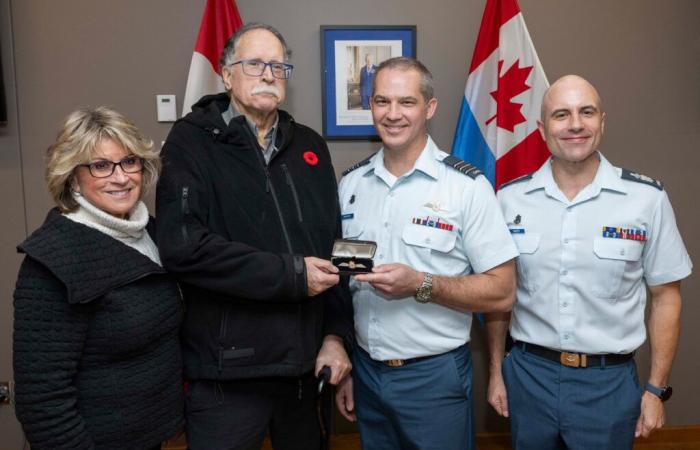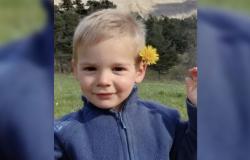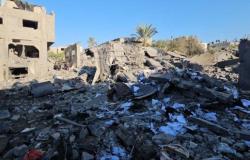Jay Hammond receives a set of wings created from aluminum from his uncle’s salvaged Halifax bomber during a commendation presentation to the 443rd Maritime Helicopter Squadron on October 18. Photo: Able Seaman Jordan Schilstra, MARF(P) Imaging Services
Paul Dagonese,
Lookout Editor
—
On the occasion of the centennial of the Royal Canadian Air Force (RCAF), two exceptional Canadians were honored for their significant contributions to Canada’s military history. At a ceremony held Oct. 18 at 443 Maritime Helicopter Squadron in North Saanich, Jay Hammond and Maureen Thom were recognized for their dedication over the past 13 years in recovering the site where their uncle’s plane crashed during World War II and to exhume the wreckage seven meters underground.
On 12 May 1944, Halifax bomber LW682 carrying seven RCAF and one Royal Navy crew was shot down by a Luftwaffe Messerschmitt Bf 110. The plane and its crew died in the accident. Their remains remained submerged in a Belgian marsh for decades. Fifty-three years later, the remains of Hammond’s uncle, Pilot Officer Wilbur Boyd “Wib” Bentz, a Canadian bomber pilot, and two of his crew members, Sergeant JW Summerhayes and Sergeant F. Roach, were discovered at the crash site of their Halifax bomber, near Geraardsbergen, Belgium.
Lieutenant-Colonel Matt Dukowski, Commanding Officer of 443 Squadron, opened the ceremony by presenting Hammond with a unique RCAF tribute, a set of wings (rare to receive for a civilian) fashioned from aluminum of his uncle’s Halifax bomber. In 2021, the RCAF began using salvaged bomber material in wings issued to all active members qualified for flight. The metal serves as a link between today’s RCAF and the fallen airmen who laid its foundation. Since then, each wing has had the bomber’s tail number written on the back.
LCol Dukowski said it was a “very personal connection” for each recipient, as they represent a direct part of RCAF history. “Mr. Hammond’s efforts have created a lasting legacy that honors both his family and the entire ARC community,” he said.
In a letter from Commander Eric Kenny, read aloud during the ceremony, LGen Kenny praised Hammond’s 13 years of dedication to finding the bomber and its crew members. “His dedication not only allowed his family to turn the page, but also to preserve an essential element of Canadian military heritage,” he wrote. “Jay is someone who has preserved his uncle’s memory in an incredibly special way.
Hammond and Thom, who followed in his uncle’s footsteps to become a pilot, also received the Commander’s Coin and the 443 Squadron Coin, which is limited to 100 for the centenary year of the ARC.
Touched by his uncle’s letters, Mr. Hammond embarked on a journey to uncover his family’s wartime past. Determined to locate the crash site, he worked closely with the Belgian Aviation History Association (BAHA), an organization dedicated to preserving aviation history.
In September 1997, Hammond, accompanied by Thom, arrived in the Belgian marshes to attend the first excavations. Volunteers gathered to help, and soon the aluminum fragments containing Halifax LW682 emerged from the ground, confirming that they had found the right place. The excavations were considerable, reaching nine meters below the surface and requiring three full days of work.
Hammond remembers the emotion he felt when the first recognizable artifact surfaced.
“You could hear the screech of the excavator bucket crushing the aluminum,” he says. “And when we found the tail number, LW682, there was no doubt that we were at the right site.
The searches led to the discovery of poignant objects: a watch stopped at the time of the impact, a signet ring belonging to Jack Edwin McIntyre, a member of the crew, and parachutes.
Hammond’s trip took a surprising turn when he contacted the Luftwaffe pilot known for shooting down the Halifax, Martin Drewes. Remarkably, Drewes accepted Hammond’s invitation to attend the funeral of the crew found in Belgium. On November 10, 1997, eight headstones were placed at the site for each fallen crew member. At the end of the ceremony, Hammond recognized Drewes, who had quietly traveled from Brazil to pay his respects.
Reflecting on it, Hammond saw his bond with his uncle blossom into a deep connection to the ARC and its history, while admitting that he viewed it through the prism of war. It may have been his uncle who shot down Drewes’ plane. The two men remained in contact until Drewes’ death in 2013.
The recovered bomber contributed to projects commemorating the sacrifice of Canadian crews. Parts of the aircraft were incorporated into the restored Halifax NA337, now on display in Trenton, and aluminum from the wreck was melted into ingots, some of which formed the roof of the Bomber Command Memorial in London, England , notably the ceiling of the Hyde Park memorial, where Queen Elizabeth unveiled the monument in 2012.
“Standing there, knowing that a piece of our history was now part of something so grand was indescribable,” Mr. Hammond said of his participation in the ceremony. “It was an honor to see this aluminum used in such a prestigious location.
Today, the artifacts from the crash that Hammond collected — a photograph of Bentz, his leather flying gloves, pieces of the Halifax’s aluminum and defused incendiary shells — serve as lasting reminders of courage. Thanks to Hammond’s dedication, these symbols continue to honor the legacy of a nephew’s mission to ensure his uncle’s memory lives on in the proud heritage of the RCAF.
As the RCAF celebrates its 100th anniversary, this tribute to Jay Hammond and Maureen Thom highlights the Air Force’s commitment to honoring its legacy and those who shaped it. By recognizing their dedication, the RCAF ensures that the memory of Canada’s fallen airmen continues to inspire future generations.






